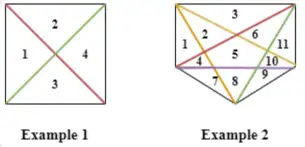Topics
You have given Convex N-gon. Draw all diagonals of the convex N-gon. Suppose no three diagonals pass through a point. Into how many parts is the N-gon divided?
Input:
2 (num test cases)
4
5
Output:
4
11

Idea
- Start with one region
A convex n-gon is one whole region before any diagonals are drawn - Count the diagonals
There are diagonals in an n-gon. If you imagine drawing a diagonal that doesn’t intersect any others, it would simply cut one region into two, thus “contributing” one new region. So, if the diagonals didn’t cross, you would contribute regions - Count the intersections
Any set of 4 vertices forms a convex quadrilateral, and its two diagonals cross exactly once. Thus, the total number of intersection points is - Each intersection adds one region
When a new diagonal is drawn, if it crosses already-drawn diagonals, each crossing splits an existing segment of the diagonal, thereby increasing the total count of regions. Summing over the process, each intersection contributes an extra region - Putting it all together:
- Start with 1 region.
- Add regions (one per diagonal).
- Add regions (one per intersection).
Thus, the total number of regions inside the n-gon is
This elegant formula arises from counting the “cuts” made by the diagonals and their intersections in a systematic way.
Code
ll MOD = 1000000007;
ll binpow(ll a, ll b) {
if (b == 1)
return a % MOD;
ll tres = binpow(a, b >> 1);
ll res = (tres * tres) % MOD;
if (b & 1)
res = (res * a) % MOD;
return res;
}
ll inv(ll a) { return binpow(a, MOD - 2); }
ll nCr(ll n, ll r) {
ll res = 1;
for (int i = 0; i < r; ++i) {
res = (res * (n - i)) % MOD;
res = (res * inv(i + 1)) % MOD;
}
return res;
}
void solve() {
ll n;
cin >> n;
// straightforward formula application
ll res = 1 + ((n*(n-3) % MOD) * inv(2))%MOD + nCr(n, 4);
cout << (res + MOD) % MOD << endl;
}Implementation relies on efficient binomial coefficient using factorials calculation.